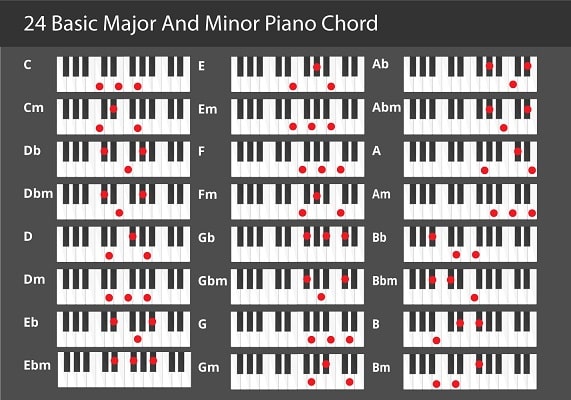
The Best Way to Learn Piano Scales
Why learn piano scales? There are several really important reasons:
- Practice discipline and warm-up
- Dexterity and control of speed
- Independence of hands
- Knowledge of key signatures
- Scales turn up in many pieces of music
There are many types of scales, but for most people learning the piano, it’s fine to learn the basic major and minor in each key, making a total of 24 scales.
I’m going to be talking about playing scales in one octave first. It’s very important to play one octave scales many times before going to two octaves to get the notes firmly in your mind and the pattern of notes into your fingers.
If you’re already learning the piano, you will know that we refer to each finger as numbers 1 through 5. So in each hand, the thumbs are referred to as finger number 1 and the little fingers are referred to as finger number 5 with the middle digits being fingers 2, 3 and 4.
How to Play a One Octave Scale
Using the right hand alone, start with your thumb on middle C. Play C, D and E with fingers 1, 2 and 3. Then tuck your thumb under finger number 3 while it’s holding the note E down, and place your thumb on the next note, F, bringing the other fingers to rest over the next set of notes. Then continue playing fingers 2, 3, 4 and 5, which will now play the notes G, A, B, and C.
Now you want to return to middle C, so play fingers 4, 3, 2 and 1, which lands on F, pivot your hand over your thumb and place finger number 3 on E, then fingers 2 and 1 continue downwards playing D and C.
The left hand is a mirror image of the right hand, so it works the other way around. You start with your 5th (little) finger on the note, C, then play 5, 4, 3, 2, 1 and put finger number 3 over your thumb to get to the next note, A, which leaves you with fingers 2 and 1 to play the last two notes, B and C. And there’s your one octave scale in the left hand.
Take a look at this video which shows you very clearly how to achieve a one octave scale in C in each hand. Note that there are no black notes in a C major scale:
Once you’ve mastered a one octave scale in each hand you can move on to two octaves.
Practicing each hand separately is essential so that each hand is independently capable and this makes playing hands together easier to achieve. Also, practice slowly and steadily. A metronome is a good idea for one minute to help keep the notes even and control your speed.
If you want to learn the piano well, it’s crucial to get this right, right from the start, so either uses YouTube tutorials for visual help or invest in some lessons. A teacher can see what you’re doing wrong and correct you right away whereas using YouTube you can get into some bad habits without realizing it.
How to Play a Two Octave Scale
Playing two octaves starts out the same as one octave. Place your thumb on C and play C, D, and E with fingers 1, 2 and 3, then tuck your thumb under onto the next note, F, just as you did playing one octave. Place all your fingers over the next group of notes and continue climbing up on notes G, A and B with fingers 2, 3 and 4.
This time, instead of playing C with finger number 5, tuck your thumb under again and place it on C, bringing the rest of your fingers to cover the next set of notes. Now start the next octave just as you started the first: play D and E with fingers 2 and 3 then tuck your thumb under again to play F. Then continue up the scale with fingers 2, 3, 4 and 5 playing notes G, A, B, and C.
That’s the ascending scale of C in 2 octaves. Think of the fingering as “3, 4, 3” – where your thumb goes under.
To reverse the scale, walk down the notes until you play F with your thumb, then put your 3rd finger over your thumb onto note E (keep your thumb down on the F to use it as a pivot), then play 2 on D and 1 on C. Now put your 4th finger over your thumb onto note B and continue down till you get to thumb on F, then put your 3rd finger over onto E again, and finish the scale with D and C with fingers 2 and 1. Note that you are exactly reversing what you did going up the scale.
Here is a good tutorial on how to play a two octave scale of C major in each hand:
The scales of C, D, E, G and A majors and minors all use this fingering. Other scales use different fingering because of where you encounter black notes. Also, although the fingering is the same as C major, the other scales mentioned above encounter black notes (sharps and flats) so you need to learn the key signatures to learn them, which is another subject.
Although many people think of scales as boring, they actually become a lot of fun to play once you’ve mastered them and get some speed up on them. Push the speed up very gradually over time, using a metronome. Practice scales for a few minutes daily and you’ll see a marked difference in your finger dexterity and independence of hands. Have fun!
